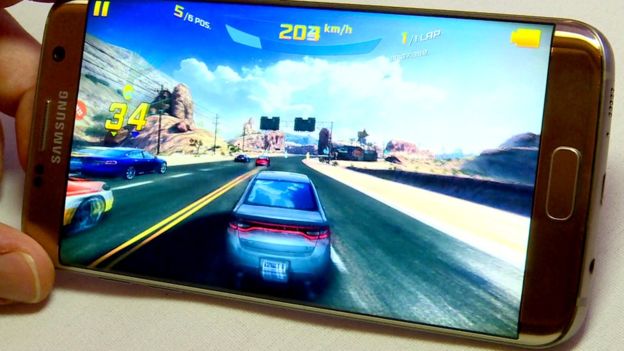
Samsung’s latest flagship phones restore a couple of popular features dropped from the previous generation.
The Galaxy S7 and Galaxy S7 Edge both accept MicroSD cards, allowing their storage to be expanded, and can also be submerged underwater.
In addition, they feature new gaming tech and a rear camera that should cope better in low-light conditions.
Their overall design, however, is similar to the Galaxy S6 line-up.
Some experts suggested that could pose a challenge.
“Although there are significant improvements under the bonnet with the camera, the chipset, the removable storage and the water resistance, Samsung will have to make sure that’s visible to consumers,” commented Ian Fogg from the IHS Technology consultancy.
“Because at a glance they look to be the same as last year’s model.”

Samsung does not disclose smartphone sales numbers. However its share of the market dropped by 2% in 2015, according to research firm IDC, at a time when Apple, Huawei and Xiaomi made gains.
Even so, IDC’s data still indicates the South Korean firm remains the bestselling brand by a wide margin.
The new devices were unveiled in Barcelona on the eve of the Mobile World Congress tech show.
Optimised for games
While the Galaxy S7 retains the same sized screen as the S6, the S7 Edge’s display has grown slightly from 5.1in (13cm) to 5.5in (14cm).
The Edge version is also slightly curvier than before and its camera protrudes less far out.
In addition, the “edged” parts of the screen now provide shortcuts to email, different photo modes and third-party apps.
Both phones:
now accept MicroSD cards with up to 200 gigabytes of storage, which fit onto the same tray as their SIM cards
have higher capacity batteries – the S7 Edge can reportedly play up to 15 hours of high definition video on a charge
have IP68 water resistance ratings, meaning they can be safely immersed to depths of 1.5m (4.9ft) for up to 30 minutes
have an “always on display” function that shows notifications and the time without needing to wake the screen up
retain the wireless charging capabilities of the S6 models
They also feature processors that are faster than before and capable of supporting the Vulkan API (application program interface).
This is an open standard that lets games make more efficient use of a chip’s graphics processing units (GPUs). Modern PCs and games consoles can already support Vulkan, but Samsung says its smartphones are the first to do so.
The firm has also added a “thermal spreader” to the phone’s innards. This is a 0.4mm-thick tube of water that turns to steam, cooling down the processor, when required.
It should allow the handset to better handle graphics-intensive titles without overheating.
In addition, Samsung has made it easier to record gameplay for later playback.
Dual pixel autofocus
The new rear camera introduces two innovations.
Firstly, it has a bigger aperture of f/1.7 rather than f/1.9. This means the lens lets in nearly double the amount of light than before. The pixels are also slightly bigger, which should mean the phones are more capable at taking low-light photos without the need for flash.
Secondly, its sensor is the first on a smartphone to feature “dual pixel autofocus”.
This means each pixel can be used to both record the image and determine focus rather than just one or the other. This enables the phone to lock focus to an object more quickly for stills, and deliver smoother focus tracking in video mode.
The technology was first developed by Canon, and until now was limited to the Japanese firm’s DSLR (digital single-lens reflex) and Cinema cameras.


























